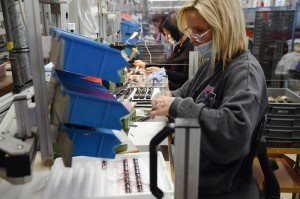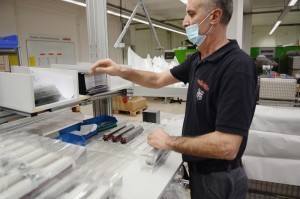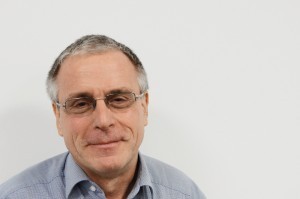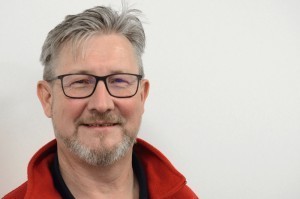The Märklin brand has been synonymous with model trains for more than 100 years. The Swabian family business Gebr. Märklin & Cie. GmbH started out as a broad-based manufacturer of toys. Then as now, metal is the preferred material - and this includes every kind of surface technology.
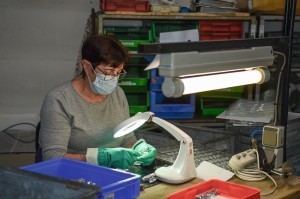 Cast blanks are subjected to a 100% visual inspection There are many public model railroad layouts in Germany: from the Miniature Wonderland in Hamburg to the new layout in the Märklineum in Göppingen and the Hans Peter Porsche Dream World in Anger in the far south, almost near Salzburg. Even the former Minister of the Interior Horst Seehofer has already given an insight into his private layout in his house in Altmühltal in a TV report. There are also many model railroad layouts in other households.
Cast blanks are subjected to a 100% visual inspection There are many public model railroad layouts in Germany: from the Miniature Wonderland in Hamburg to the new layout in the Märklineum in Göppingen and the Hans Peter Porsche Dream World in Anger in the far south, almost near Salzburg. Even the former Minister of the Interior Horst Seehofer has already given an insight into his private layout in his house in Altmühltal in a TV report. There are also many model railroad layouts in other households.
It is highly likely that these are model trains from Märklin, as the Göppingen-based company is the market leader in this segment with a turnover of around 113 million euros in the 2020/2021 financial year.
"We make everything that goes into running a train," explains Gerhard Tastl, Head of Production at the company's Göppingen site. "So trains, carriages, tracks, points, signals and so on." Accessories such as houses, trees and human figures are not part of the company's production scope.
Although electrical and electronic components are bought in, the company's vertical integration is incredibly high. This is because all mechanical parts are manufactured in-house, right down to the smallest screw. Bodies, axles, wheels, couplings, pantographs and much more are created using the respective manufacturing methods, e.g. casting, milling or stamping. And in various sizes: With a market share of around 70%, H0 scale models are the most widespread among model railroaders. With a track width of 16.5 millimetres, this results in models on a scale of 1:87. 1 gauge, with a track width of 45 millimetres, produces models on a scale of 1:32. And Z gauge, with a width of 6.5 millimetres, produces models on a scale of 1:220 and therefore the smallest models. Since Märklin bought the manufacturer Trix in 1997, there are also 1:160 scale models (Minitrix N gauge, 9 millimeters). The manufacturer Lehmann-Gross-Bahn (LGB), which was taken over in 2007, brought along 1:22.5 scale models - the latter are used almost exclusively as garden railroads due to the large amount of space they take up.
 Carefulness: Galvanic baskets are loaded and unloaded by hand "Regardless of the gauge size we are talking about, the rule of thumb is: the more detailed a model is, the more expensive it is," says Gerhard Tastl. "Steam locomotives are more complex than electric locomotives." In fact, a finished electric locomotive usually consists of 150 to 200 individual parts, whereas a steam locomotive consists of around 300 parts.
Carefulness: Galvanic baskets are loaded and unloaded by hand "Regardless of the gauge size we are talking about, the rule of thumb is: the more detailed a model is, the more expensive it is," says Gerhard Tastl. "Steam locomotives are more complex than electric locomotives." In fact, a finished electric locomotive usually consists of 150 to 200 individual parts, whereas a steam locomotive consists of around 300 parts.
The production cycle of a locomotive, for example, usually begins with the casting of the body. Almost all Märklin models have a die-cast zinc body. Attachments and fixtures such as windows and insulators are produced by injection molding. After the casting process and the subsequent quality control, all necessary feed-throughs and screw holes are drilled immediately, followed by the usual mechanical treatments such as tumbling, brushing, blasting and rounding of the edges.
The blank is then cleaned and phosphated. The base color is then applied. This is followed by partial coloring and finally finishing with the design (application of logos, stripes, etc.). Then it's on to final assembly.
The central component of production is therefore surface technology. Its head is electroplating technician/master craftsman Michael Ludwig. "In electroplating, we are proficient in all classic processes such as cyanide copper, nickel or black nickel. We can also electroplate any size of component, from XXS to XXL." Ludwig particularly emphasizes that the Göppingen-based company still uses an old, now rare electroplating process known as bell electroplating. This is a particularly gentle form of barrel electroplating. And something else is important to Ludwig: "Märklin operates two production sites. But there is only one electroplating facility at the Göppingen site."
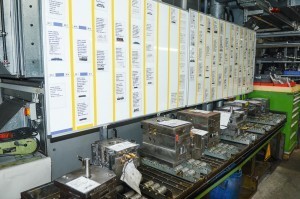 A look into the foundry: molds for various models In addition to the electroplating shop, there is of course a paint shop that can produce almost any color of an original locomotive or wagon. Ludwig: "We can produce more than 350 shades in the various color systems RAL, RAL design, HKS or Pantone in our paint shop and our pad printing shop. After all, it goes without saying that a customer who orders the legendary DB rail bus will want it in its classic dark red base color and not just any old red.
A look into the foundry: molds for various models In addition to the electroplating shop, there is of course a paint shop that can produce almost any color of an original locomotive or wagon. Ludwig: "We can produce more than 350 shades in the various color systems RAL, RAL design, HKS or Pantone in our paint shop and our pad printing shop. After all, it goes without saying that a customer who orders the legendary DB rail bus will want it in its classic dark red base color and not just any old red.
"One of our most important departments is therefore the documentation department," reveals Michael Ludwig. This department is in contact with the most important manufacturers of the "real" trains and requests (and usually receives) the original plans of the locomotives and the various carriages. Ludwig gives another example: "Imagine if the size of the pantographs didn't match the size of the locomotive proportionally, every collector would notice that immediately." It's a good thing that Siemens, Alstom and Co. are cooperative. It becomes more difficult when it comes to replicating historical trains. In most cases, there are only black and white images and the designers are forced to interpret grayscale in color. "We make three crosses every time we can find an eyewitness," winks Ludwig.
The question arises as to which of the countless real-life locomotives will make it into Märklin's model line. Market experience is required, but new developments are always a risk. Production Manager Gerhard Tastl: "A completely new development, from the idea to the first production step, costs the company around 500,000 euros, complex models even more. Once development has started, there is no going back." What's more, current models are generally only sold in the year of production and are not kept in stock later, or only to a very limited extent. Anyone who wants to buy a corresponding part later has to do so at collectors' markets or in specialist stores. The business is therefore very much characterized by new editions, but classics such as the aforementioned rail bus, the "Crocodile" from Switzerland or the German economic miracle locomotive V 200.0 are always popular and are, so to speak, always in the range.
While a (Märklin) train set was at the top of children's wish lists until well into the 1970s, this changed with the advent of computer games in the 1980s. SuperMario and PacMan replaced the "Adler", the "Rockets" and even the ICE and TGV. But only temporarily. For a few years now, model trains have been booming again. And the various lockdowns during the coronavirus crisis have boosted the boom even further. The steam horse has been rediscovered. The Göppingen-based company has identified three groups of buyers: Beginners and children, who are served with simple, inexpensive sets of locomotives, wagons and rails. Then there are the model railroaders, who recreate actual driving situations plus a realistic environment with mountains, fields and villages, and finally the classic collector, who puts individual models in the display case just to look at them.
Like so many areas of life, the model train market has also changed, regardless of which group of buyers is being targeted. Digitalization has also made inroads here. The transformer with forward and reverse switching has had its day. Thanks to computer control, even the layman can now implement complicated timetables, create lighting effects as dusk falls, or even make the rhythmically precise pounding of the steam locomotive or the squealing of the brakes. And of course the model railroader can also record station announcements. This is where model building clearly differs from reality. A station announcement is completely unknown among model railroaders: "The ICE from Frankfurt is 30 minutes late today!"
INFO
The company at a glance
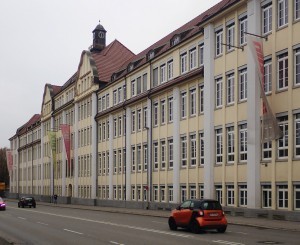 Märklin was founded in 1859 by Theodor Friedrich Wilhelm Märklin and his wife Caroline was actively involved. It is said that she was the first female traveling saleswoman, as she not only built up the business in southern Germany, but also in Austria and Switzerland. At the time, the business produced everyday goods, but also accessories for doll's kitchens, toy baby carriages and carriages. Theodor Friedrich Wilhelm dies young due to a tragic accident. In addition to the company, he leaves behind two sons. They take over the business in 1888 and from then on trade under the name Märklin Bros. At that time, the product range included toys for girls, model ships, carousels, spinning tops and floor runners. In 1891, the brothers take over the tin toy manufacturer Ludwig Lutz in Ellwangen, and in the same year they present a model train for the first time at the Leipzig Spring Fair. The train was still operated by clockwork and ran on an 8-shaped track. Since then, the company has specialized more and more in model railroads.
Märklin was founded in 1859 by Theodor Friedrich Wilhelm Märklin and his wife Caroline was actively involved. It is said that she was the first female traveling saleswoman, as she not only built up the business in southern Germany, but also in Austria and Switzerland. At the time, the business produced everyday goods, but also accessories for doll's kitchens, toy baby carriages and carriages. Theodor Friedrich Wilhelm dies young due to a tragic accident. In addition to the company, he leaves behind two sons. They take over the business in 1888 and from then on trade under the name Märklin Bros. At that time, the product range included toys for girls, model ships, carousels, spinning tops and floor runners. In 1891, the brothers take over the tin toy manufacturer Ludwig Lutz in Ellwangen, and in the same year they present a model train for the first time at the Leipzig Spring Fair. The train was still operated by clockwork and ran on an 8-shaped track. Since then, the company has specialized more and more in model railroads.
Today, Märklin is the market leader in the field of model railroads. There are two production sites. One is still in the Swabian town of Göppingen, where around 470 employees work and where the electroplating shop is also located. The other is in Györ, Hungary, where between 700 and 800 people work, depending on the season. Turnover of around 113 million euros was achieved in the 2020/2021 financial year.



